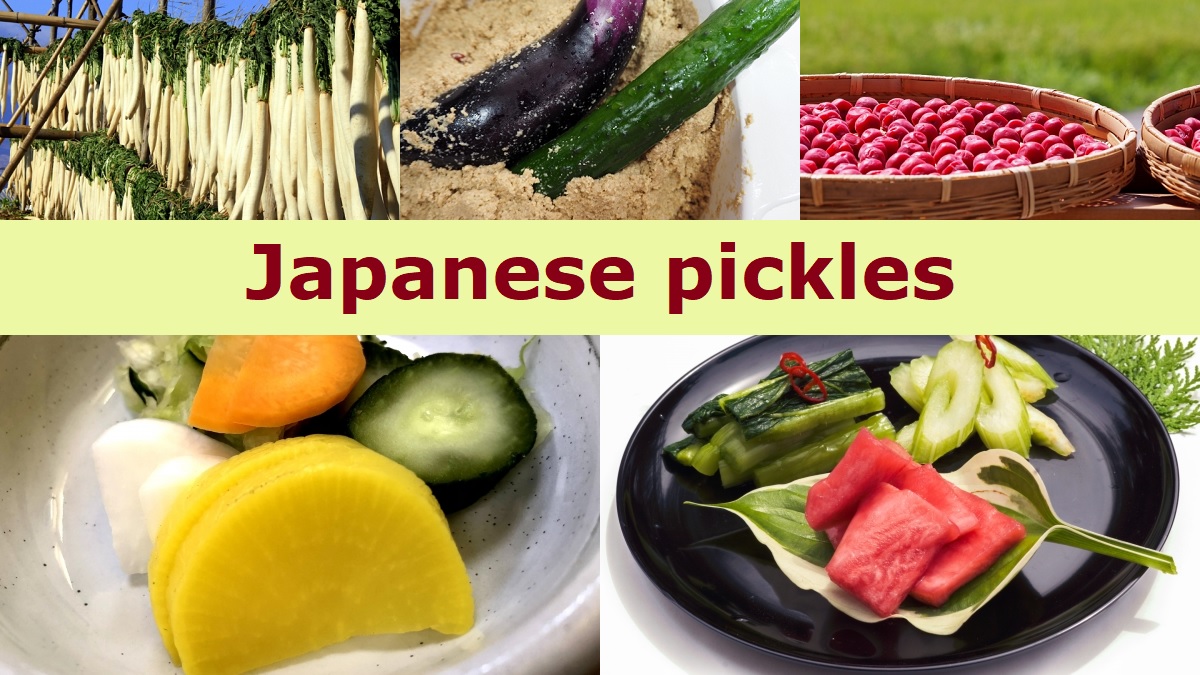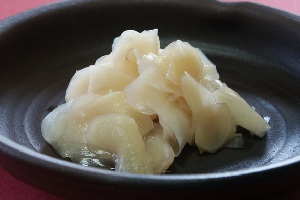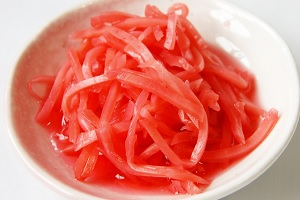Japanese pickles
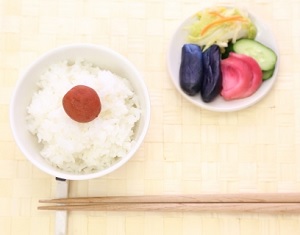
Gohan and Japanese pickles
There are many kinds of pickles in Japan.
When you eat Japanese meal, maybe a small plate of Japanese pickles is served.
Since a long time ago, pickling was one of the fundamental ways to preserve food in Japan, so pickles is a daily essential.
Most Japanese pickles are pickled in salt, rice bran (nuka), sake lees, miso or vinegar.
Daikon (Japanese radish), Hakusai (Chinese cabbage), cucumbers, turnips, eggplants, gingers are mainly used among vegetables.
And ume (Japanese plum) is used among fruits.
In Japanese, pickles are called Tsukemono or politely Otsukemono.
The following pickles are popular across the country.
In addition, Kyoto has various local tsukemono, and they are the popular souvenirs in Kyoto.
Popular pickles
Umeboshi
Umeboshi is a pickle of ume (Japanese plum) fruit, and is the pickles which is consumed the most.
It is red and tastes very salty and extremely sour.
Ume is a kind of fruit-bearing tree.
It blossoms in early spring and bears fruit in early summer.
The fully-ripened ume fruits are packed in barrels with salt, and a weight is placed on the top.
During some days, the fruits gradually exude juices.
Then, some red perilla herbs are added in the juice, so the fruits become red.
After some weeks, the fruits are dried in the strong summer sunshine for a few days.
Those are umeboshi.
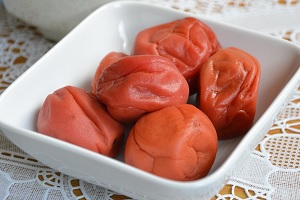
Umeboshi
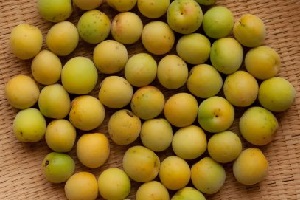
Fully-ripened ume fruits for umeboshi
Umeboshi is usually eaten with rice.
Sometimes, one or two pieces of umeboshi are served for breakfast at ryokan.
(When you put an umeboshi on the rice, it looks like the flag of Japan.)
Umeboshi has a large seed.
When you eat umeboshi, you must remove the seed.
Wakayama Prefecture is famous as a main production center for good umeboshi.
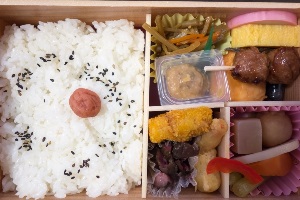
Umeboshi in Ekiben
(Lunch box sold in raiway station)
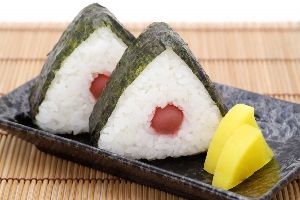
Onigiri with umeboshi
Takuan
Takuan is a popular and traditional pickle in Japan.
It is made from daikon (Japanese radish), and the color is usually yellow.
Commonly sliced takuan is serve.
First, harvested daikons are hung in the sun for some weeks.
Then, they are placed in a pickling crock, covered with a mix of salt, rice bran (nuka) optionally sugar and dried persimmon peels.
And a weight is placed on top of the crock.
Generally, "kuchinashi" (common gardenia), which is a kind of asian flowers, is added and it makes daikon yellow.
Asa-zuke
Asa-zuke is a pickle that it is easy to make at home.
After rubbing chopped vegetables with salt, it is made by pickled them with chopped konbu or red pepper in a container for one day.
As the ingredient of asa-zuke, hakusai (Chinese cabbage), cabbage, eggplant, cucumber, turnip, carrot, etc. are used.
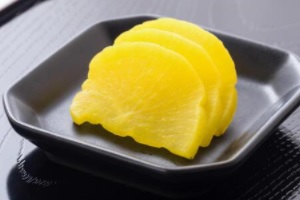
Takuan
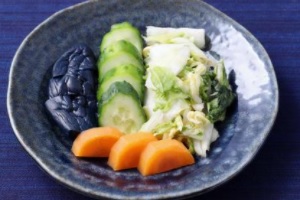
Asa-zuke
Nozawana-zuke
Nozawana-zuke is the pickle of a leaf vegetable.
Nozawana is one of a Japanese variety of mustard leaf, and is harvested in the highland of Nagano area.
The harvested leaves and stems are packed in barrels with salt.
Because it is made in cool area and ferments slowly, the taste is mild.
It is a popular pickle, and you can find even in Tokyo area.
Nara-zuke
Nara-zuke is a pickle of asian melon or cucumber.
It is said that this pickle was created in Nara city in the 8th century.
The ingredients are packed in barrels with salt, then a weight is placed on the top.
So the liquid of the ingredients is exuded.
After that, they are covered with sake lees. So it has smell of alcohol.
And the pickle becomes tortoiseshell color.
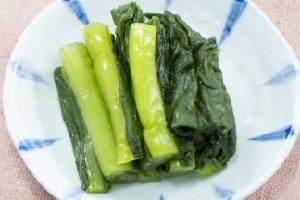
Nozawana-zuke
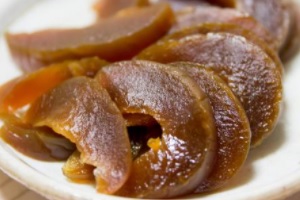
Nara-zuke
Fukujin-zuke
Fukujin-zuke is also popular kinds of pickles, and commomly used as a garnish for Japanese curry.
Seven kinds of vegetables including daikon, eggplant, lotus root and cucumber are chopped, then pickled in a base that flavored with shoyu and mirin.
So it has salty-sweet taste.
And it is colored red or orange with color additive.
"Fukujin" means Seven Lucky Gods.
It comes from using seven different kinds of vegetables.
Senmai-zuke
Senmai-zuke is the pickle of a thin-sliced turnip.
It is one of popular pickles of Kyoto.
The turnip harvested around Kyoto is sliced very thinly, and they are pickled in vinegar with Konbu and red pepper.
This is made in winter.
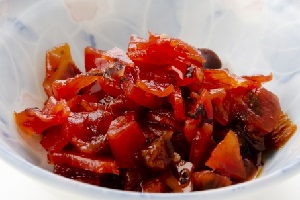
Fukijin-zuke
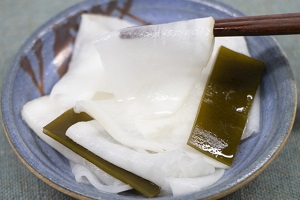
Senmai-zuke
Gari
Gari is a pickles of thin-sliced young ginger, and is light pink in color.
You can certainly eat it at sushi restaurant.
It is marinated in a solution of vinegar and sugar.
Beni-shoga
Beni-shoga is also a pickles of ginger.
It is cut into thin strips, and is pickled in the solution used to make umeboshi.
So it is red in color.
"Beni" means red, and "shoga" means ginger.
Beni-shoga is often topped on gyudon, yaki-soba (fried Chinese noodle).
And, chopped beni-shoga is mixed into okonomiyaki and takoyaki.
Rakkyo
Rakkyo is a white bulb of vegetable like shallot.
It is harvested in Japan and China.
It has the taste and smell mixed onion and garlic.
Commonly it is made by pickling in vinegar and sugar.
Rakkyo is harvested around early summer, and the pickles are also made at home.
You can find it as a relish for Japanese curry.
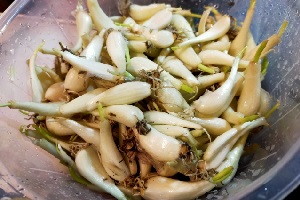
Rakkyo
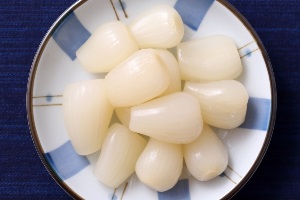
Pickles of Rakkyo

